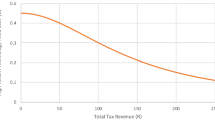Abstract
Endogenous population growth, i.e., making the rate of population growth dependent on society's opulence, causes parametric changes to have a larger impact and can cause multiplicity of steady states in a dynamic intertemporal optimization framework. This provides a simple explanation for the possibility of differing growth paths between countries (using a standard production function) or another explanation of the ‘poverty trap’. We give two examples (‘opulence sensitivity’ and ‘production sensitivity’) that both give rise to three steady states in which poor (rich) countries will evolve over time to the low (high) income steady state. In both examples there are middle income countries that will choose the low (high) income steady state if they are impatient (patient), where patience is measured through the rate of time preference o. Foreign aid in the form of a large transfer of capital from abroad enables poor and impatient middle income countries to move to the high income steady state.
Similar content being viewed by others
References
Barro RJ, Becker GS (1989) Fertility choice in a model of economic growth. Econometrica 57:481–501
Benhabib J, Jovanovic B (1991) Externalities and growth accounting. Am Econ Rev 81:82–113
Blanchard OJ, Fischer S (1989) Lectures on macroeconomics. MIT Press, Cambridge, MA
Blomqvist AG, Pitchford JD (1977) Population policy, individual welfare and optimal economic growth. Mimeo Australian National University
Brock WA, Malliaris AG (1989) Differential equations, stability and chaos in dynamic economics. North-Holland, Amsterdam
Cigno A (1992) Children and pensions. Presidential address to the European Society for Population Economics, Pisa. J Popul Econ 5:175–183
Dechert WD, Nishimura K (1983) A complete characterization of optimal growth paths in an aggregated model with a non-concave production function. J Econ Theory 31:332–354
Dellas H, de Vries CG (1991) Piecemeal versus precipitous factor market integration. University of Leuven, CES discussion paper no. 82
Ehrlich I (1990) The problem of development: Introduction. J Polit Econ 98:s1-s11
Liviatan N, Samuelson PA (1969) Notes on turnpikes: stable and unstable. J Econ Theory 1:454–475
Lucas RE Jr (1988) On the mechanics of economic development. J Mon Econ 22:3–42
Mankiw NG, Romer D, Weil DN (1992) A contribution to the empirics of economic growth. Q J Econ 107:407–437
Nelson RR (1956) A theory of the low level equilibrium trap in underdeveloped economies. Am Econ Rev 46:894–908
Pitchford JD (1974) Population in economic growth. North-Holland, Amsterdam
Raut LK (1991) Capital accumulation, income distribution and endogenous fertility in an overlapping generations general equilibrium model. J Dev Econ 34:123–150
Romer PM (1986a) Increasing returns and long-run growth. J Polit Econ 94:1002–1037
Romer PM (1986b) Cake eating, chattering, and jumps: Existence results for variational problems. Econometrica 54:897–908
Rosenzweig MR (1990) Population growth and human capital investments: Theory and evidence. J Polit Econ 98:08-s70
Sato R, Davis EG (1971) Optimal savings policy when labor grows endogenously. Econometrica 39:877–897
Skiba AK (1978) Optimal growth with a convex-concave production function. Econometrica 46:527–539
Unites Nations (1983) Statistical Yearbook World Bank (1987)
World development report
Author information
Authors and Affiliations
Additional information
We would like to thank Nico Heering, Martijn Herrmann, Theo Junius, Ngo van Long, Ad Pikkemaat, John Pitchford, Lakshmi Raut, Casper de Vries, an anonymous referee, participants of workshops at the University of Groningen and the University of Amsterdam and especially Harry van Dalen for valuable comments. The article was presented at the fifth annual conference of the European Society of Population Economics, Pisa 1991. The views expressed in the article are those of the authors and not necessarily those of the World Bank.
Rights and permissions
About this article
Cite this article
van Marrewijk, C., Verbeek, J. On opulence driven poverty traps. J Popul Econ 6, 67–81 (1993). https://doi.org/10.1007/BF00164339
Received:
Accepted:
Issue Date:
DOI: https://doi.org/10.1007/BF00164339




